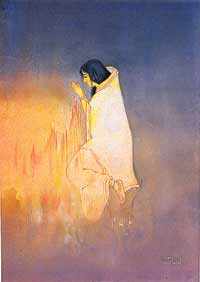on
Rhythms of India: The Art of Nandalal Bose
 The Philadelphia Museum of Art has a great exhibition up with its Rhythms of India: The Art of Nandalal Bose. I’m generally interested in all things Indian. I am also generally interested in any artist who is strongly inspired by his or her faith to do work, and this is certainly true of Bose.
The Philadelphia Museum of Art has a great exhibition up with its Rhythms of India: The Art of Nandalal Bose. I’m generally interested in all things Indian. I am also generally interested in any artist who is strongly inspired by his or her faith to do work, and this is certainly true of Bose.
Bose was a contemporary of Gandhi’s and put a lot of energy into doing artwork that would support Gandhi’s efforts. He also firmly believed in reviving old Indian art styles as they got the imperialists out of the country. When he was working in a region of India, he only used materials from his immediate surroundings to make his art.
The aspect I found most interesting about Bose, though, was his last years. Apparently, in Hindu thinking (according to the exhibition’s narrative), there is a strong idea that life has four phases. In the last phase, one is to turn their mind toward God and set aside public life. How different is that from American leaders (* cough * McCain * cough *) who just can’t ever let go.
And the artwork from the end of Bose’s life is so thoughtful yet so minimal and sparse. So simple and yet so deep. It was definitely my favorite part of a beautiful show and a real example in the virtue and beauty to be found in living in the natural order of each phase of one’s existence. I wish I had an example to show you. The piece above, Sati, is actually from his very early years. A work that won him great renown and captured the imaginations of his countrymen, reviving their pride in being Indian and Hindu.
Looking at Bose’s final works, it seems that there really is something to be gained by going gently into that good night.
Note from 2020: This remains one of those exhibitions that has stuck with me.